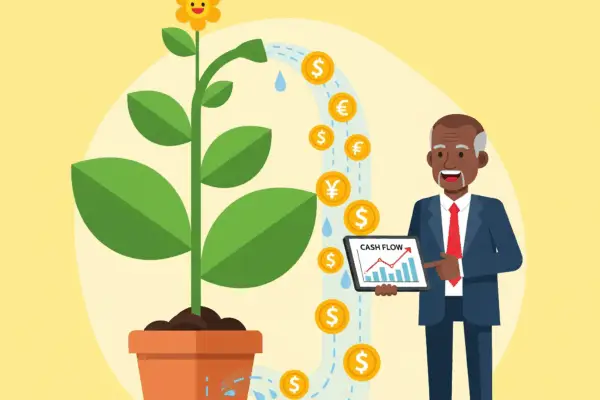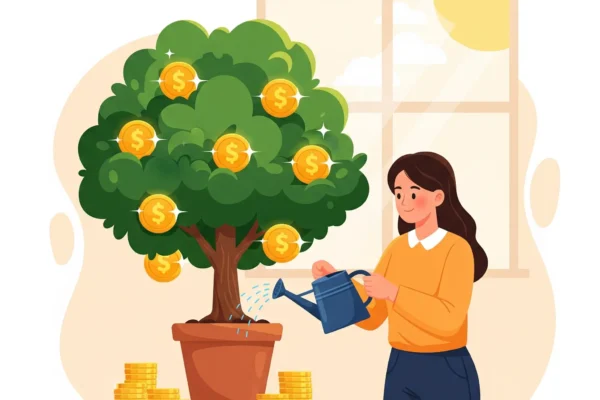You just landed a new customer! High five! You probably did a little happy dance, right? All that hard work, the marketing, the late nights, it all paid off for that one sale. But what happens next? Does the focus immediately shift to finding the next new customer, almost forgetting about the one you just earned?
If that sounds familiar, you’re not alone. Many businesses, especially small ones, pour almost all their energy, time, and money into finding brand-new customers. It feels like a constant race to get more sales. But what if I told you there’s a powerful secret to growing your business that’s often overlooked? What if the real key to lasting success isn’t just about getting new customers, but about turning the ones you already have into loyal, repeat buyers and even enthusiastic cheerleaders for your business?
This is called customer retention, and it’s gold for your business. Think about it: it can be much cheaper and easier to get someone who already knows and likes you to buy again than to convince a complete stranger to trust you for the first time. Turning first-time customers into lifelong fans isn’t just a nice idea; it’s absolutely essential for building a strong, lasting business. This post will show you how to do it. We’ll explore simple, practical ways to make customers love you so much they keep coming back, spend more over time, and even tell all their friends about you. Get ready to learn the secret to sustainable growth!
Part 1: The Foundation – Making the First Impression Last
Think about meeting someone new. That first impression matters a lot, right? The same goes for your customers. The moment they buy something from you, or use your service for the first time, sets the whole tone for their relationship with your business. You want that first experience to be amazing, so they feel good about their choice and want to come back.
1. Deliver an Exceptional “First Experience”
The magic begins the instant a customer decides to buy from you. This isn’t just about the product itself, but the entire process. You want them to feel like they made the absolute best choice.
- Make it Smooth and Easy: From clicking “buy” on your website to walking out of your physical store, make the process simple. No confusing steps, no hidden fees, no long waits. If buying from you is a hassle, they might not bother again.
- Online Example: If you sell handmade jewelry online, your checkout process should be clear. They should know exactly what they’re paying, when it will ship, and how to contact you.
- In-Store Example: If you run a coffee shop, your ordering and pickup should be quick and friendly.
- Clear Communication is Key: Customers hate being left in the dark. Keep them informed every step of the way.
- Order Confirmations: Send an immediate email confirming their purchase.
- Shipping Updates: Let them know when their order ships and provide tracking information.
- Service Appointments: Send reminders for appointments and confirm details.
- Meet, Then Exceed Expectations: Your product or service needs to do what you promised. But to truly stand out, try to do a little more.
- Example: If you sell a garden tool, make sure it’s high quality. But what if you also included a small, helpful guide on common gardening mistakes? Or a packet of bonus seeds?
- Example: If you offer house cleaning, make sure the house is spotless. But what if you left a small, folded towel in the bathroom or a note saying “Enjoy your sparkling home!”?
- Why it Matters: A fantastic first experience isn’t just about making the sale; it’s about starting a positive relationship. When customers feel good about their first interaction, they’re much more likely to think of you again. This positive feeling creates the foundation for trust and future business.
2. Seamless Onboarding & Support
Once someone buys your product or service, your job isn’t over. In fact, it’s just beginning! You need to make sure they know how to use what they bought and feel supported if they have questions. This is called onboarding, and it’s about helping them get the most value from their purchase.
- Provide Clear Instructions: Don’t assume your customers know everything.
- For Products: Include easy-to-understand instructions. If it’s a complicated item, maybe a quick-start guide or a link to a video tutorial.
- For Services: If they signed up for a new service, explain the next steps clearly. How do they access it? Who do they contact if they need help?
- Easy Access to Support: When customers have a question or a problem, they want quick, friendly help.
- FAQs (Frequently Asked Questions): Have a dedicated section on your website where common questions are answered. This allows customers to find answers on their own.
- Clear Contact Information: Make it easy for them to call, email, or chat with you. Don’t hide your phone number!
- Fast Response Times: Try to respond to questions or issues as quickly as possible. Even if you don’t have an immediate answer, a quick “We received your message and will get back to you soon!” can make a big difference.
- Welcome Email Series: For many businesses, a short series of welcome emails can be incredibly effective.
- Email 1 (Immediately after purchase): Thanks for your order! Here’s what’s next.
- Email 2 (A few days later): Tips on how to use your product, or helpful resources.
- Email 3 (A week or two later): Check-in: “How are things going? Any questions?”
- Why it Matters: When customers feel supported and successful with your product or service, they become happier. Happy customers are less likely to leave, and more likely to purchase from you again and again. It shows you care about their success, not just their money.
Part 2: Nurturing the Relationship – Staying Connected and Valued
You’ve delivered a great first experience, and they know how to use what they bought. Now, how do you keep them coming back? It’s all about staying connected and making them feel valued, not just as a sale, but as a person.
3. Personalized Communication (Beyond the Sale)
Many businesses only reach out to customers when they want them to buy something else. Don’t do that! Think about building a friendship. You don’t just call a friend when you need a favor, right?
- Send Helpful Content: Become a valuable resource, not just a store.
- Example (Pet Store): Send a newsletter with tips on pet care, seasonal advice, or new dog park openings.
- Example (Home Decor): Send articles about interior design trends, DIY decorating ideas, or how to care for certain materials.
- Leadership Insight: This is “value-added” communication. You’re giving them something useful without asking for anything in return. This builds goodwill and keeps your brand top-of-mind.
- Personalized Messages (When Possible): If you can, make your communication feel personal.
- Segmentation: Group your customers. If someone bought dog food, send them dog-related tips, not cat tips. If they bought a specific type of product, send them information related to that product.
- Remember Key Dates: A simple “Happy Birthday!” email, or “Happy Anniversary of your first purchase!” can make a big impact.
- Engage on Social Media: If customers follow you on social media, interact with them. Respond to their comments, answer their questions, and share user-generated content (with permission!).
- Why it Matters: When customers feel like you genuinely care and are providing value, they develop a deeper connection with your brand. They stop seeing you as just a business and start seeing you as a trusted friend or expert. This connection is incredibly powerful for loyalty.
4. Loyalty Programs & Exclusive Offers
Everyone loves a good deal, and everyone likes to feel special. Loyalty programs and exclusive offers are fantastic ways to reward your existing customers and give them a strong reason to choose you again.
- Simple Loyalty Programs: You don’t need anything super complicated.
- Punch Cards: “Buy 9 coffees, get the 10th free!” is a classic for a reason.
- Points Systems: Customers earn points for every dollar they spend, which can be redeemed for discounts or freebies.
- Tiered Rewards: “Silver, Gold, Platinum” levels where customers get better perks the more they spend.
- Exclusive Discounts & Early Access: Make your loyal customers feel like VIPs.
- “Members-Only” Sales: Send special discount codes only to your email list or loyalty program members.
- Early Access: Let your loyal customers buy new products or book new services before the general public. This creates excitement and makes them feel privileged.
- Birthday Rewards: A special discount or free item on their birthday.
- Why it Matters: These programs provide a clear incentive for repeat purchases. They make customers feel appreciated and rewarded for their continued business. It’s a win-win: they get perks, and you get consistent sales. It transforms a single transaction into a long-term relationship.
5. Soliciting and Acting on Feedback
Want to know how to make your customers happy? Ask them! And then, listen to what they say. Actively asking for feedback and showing that you use it is one of the quickest ways to build trust and improve your business.
- Actively Ask for Opinions: Don’t wait for them to complain. Reach out!
- Simple Surveys: After a purchase or service, send a short, easy survey asking about their experience. Keep it quick – a few questions are better than a long one.
- Direct Emails: A personal email asking, “How was everything? We’d love your honest feedback.”
- In-Person Conversations: If you have a physical store, simply ask customers at the checkout.
- Listen, Truly Listen: Don’t just collect feedback; read it carefully. Look for common themes, both positive and negative.
- Act on the Feedback (and Tell Them You Did!): This is the most crucial part. If customers suggest something, and you can make that change, do it! And then, tell them!
- Example: If several customers say your delivery times are too slow, and you find a faster shipping option, announce it! “You asked, we listened! We’ve improved our shipping speeds thanks to your feedback!”
- Example: If customers love a specific flavor of coffee, consider making it a regular menu item.
- Handle Complaints Gracefully: Negative feedback can sting, but it’s a gift. It tells you where you need to improve. Respond quickly, professionally, and empathetically. Offer solutions. Don’t get defensive. Turning a negative experience into a positive one can create a fiercely loyal customer.
- Why it Matters: When customers see that their opinions are valued and that their feedback leads to improvements, they feel heard and respected. This builds incredible loyalty and makes them feel invested in your success. They become partners in your business’s growth.
Part 3: Turning Fans into Advocates – The Power of Word-of-Mouth
You’ve made your customers happy. They’re coming back. Now, let’s take it a step further: turn them into your biggest cheerleaders. When your customers start telling their friends about you, that’s the most powerful (and free!) marketing you can get. This is called word-of-mouth marketing, and it’s gold.
6. Encourage Reviews & Testimonials
Before people try a new restaurant, buy a new product, or hire a new service, what do they often do? They check online reviews! Positive reviews are like personal recommendations from people they don’t even know, and they build massive trust.
- Just Ask! The simplest way to get more reviews is to ask for them.
- After a Positive Interaction: If a customer raves about your product, simply say, “We’re so glad you loved it! If you have a moment, we’d really appreciate it if you could leave us a quick review on [Google/Yelp/Facebook/your product page].”
- Follow-up Email: Include a polite request for a review in a post-purchase email.
- Make it Easy: Don’t make them search for where to leave a review.
- Direct Links: Provide a direct link to your Google Business Profile review page, your Yelp page, or the review section on your website.
- QR Codes: Put a QR code on your receipts, business cards, or a small sign in your store that takes them right to your review page.
- Respond to All Reviews: Whether positive or negative, take the time to respond.
- For Positive Reviews: A simple “Thank you so much! We appreciate your kind words!” goes a long way.
- For Negative Reviews: Address the issue professionally and offer to make it right. This shows potential customers that you care about your service.
- Showcase Testimonials: Don’t just collect them; display them!
- Put them on your website (a dedicated “Testimonials” page or scattered throughout).
- Share quotes on your social media (with permission, of course!).
- Why it Matters: Reviews and testimonials are social proof. They show potential new customers that real people have had good experiences with your business. This builds trust and encourages new sales. Happy customers telling others is priceless.
7. Implement a Simple Referral Program
You already have happy customers. Now, give them an extra reason to spread the word! A referral program rewards your existing customers for bringing in new business.
- The Basic Idea: Offer a reward to both the person who refers a new customer and the new customer they send your way. This makes it a win-win situation.
- Easy Examples:
- Coffee Shop: “Refer a friend, and when they make their first purchase, you both get a free coffee!”
- Hair Salon: “Tell a friend about us, and they’ll get 15% off their first haircut, and you’ll get 15% off your next one!”
- Online Store: “Share your unique referral code. Your friend gets $10 off their first order, and you get $10 credit when they complete their purchase!”
- Service Business: “Refer a neighbor for our service, and you’ll both get $25 off your next invoice!”
- How to Promote It:
- Put a small sign in your store.
- Include it in your email newsletter.
- Mention it in a friendly way when a customer expresses their satisfaction.
- Post about it on your social media.
- Why it Matters: People trust recommendations from friends and family more than any advertisement. A referral program supercharges this natural tendency. It turns your satisfied customers into an active, motivated sales force, bringing you high-quality new leads who are already predisposed to trust you.
8. Create a Community
This might sound like a big step, but creating a sense of community around your brand can lead to incredibly strong loyalty. It’s about bringing people together who share an interest in what you do.
- Online Groups:
- Facebook Group: Create a private Facebook group for your customers where they can ask questions, share tips related to your product/service, and interact with each other (and you!).
- Online Forum: If your business is highly specialized (e.g., specific hobby, unique tech product), a dedicated forum might work.
- Local Meetups/Events:
- If you have a physical location, host a customer appreciation event, a workshop related to your product, or a special sale just for loyal customers.
- Example (Craft Store): Host a weekly “knit and chat” group or a monthly DIY workshop.
- Example (Bookstore): Start a book club.
- User-Generated Content: Encourage customers to share their photos or videos using your product on social media, and then share their posts on your own channels. This makes them feel like part of something bigger.
- Why it Matters: A community fosters a sense of belonging and connection, not just to your brand, but to other people who love your brand. This makes customers feel invested in your success. They become not just buyers, but advocates, friends, and fans who support each other and you. This creates a powerful, self-sustaining loop of loyalty and engagement.
Conclusion: Your Empire Built on Loyalty
So, there you have it. The secret to powerful, lasting business growth isn’t just about endlessly chasing the next new customer. While bringing in new blood is important, the real magic happens when you focus on nurturing the relationships you already have.
Think of it this way: acquiring a new customer is like filling a bucket with a hole in the bottom. If you keep pouring water in (new customers) but don’t patch the hole (retain existing customers), you’ll never fill it up. By delivering amazing first experiences, staying connected, showing appreciation, and turning customers into advocates, you patch that hole.
Loyal customers are your business’s biggest asset. They:
- Spend more over time: They keep coming back, increasing their “lifetime value.”
- Are cheaper to serve: You don’t have to spend money advertising to them again.
- Refer new business: They become your free sales force.
- Are more forgiving: If you make a mistake, they’re more likely to give you a second chance.
- Provide invaluable feedback: They help you improve and grow.
You don’t need to be a huge corporation to do this. Even a small business can implement these strategies with consistency and genuine care.
Stop chasing endlessly for the next new customer. Instead, invest in the customers you already have. Start by picking just one or two of these ideas this week. Maybe you’ll send a personalized thank you email, or perhaps you’ll set up a simple referral program. Be consistent, be genuine, and watch your business transform from a place that just sells things to a thriving community of lifelong fans. Your business growth journey starts with the customers you already have.



